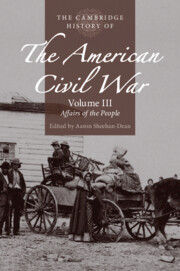Book contents
- The Cambridge History of the American Civil War
- The Cambridge History of the American Civil War
- The Cambridge History of the American Civil War
- Copyright page
- Contents
- Plates
- Figures
- Contributors to Volume III
- Note on the Text
- Part I Values
- 1 Wartime Masculinities
- 2 Northern Women and the Civil War
- 3 Southern Women and the Civil War
- 4 Religion in the Civil War Era
- 5 Economic and Social Values in the Civil War
- Part II Social Experience
- Part III Outcomes
- Index
- Plate Section (PDF Only)
- References
2 - Northern Women and the Civil War
from Part I - Values
Published online by Cambridge University Press: 11 October 2019
- The Cambridge History of the American Civil War
- The Cambridge History of the American Civil War
- The Cambridge History of the American Civil War
- Copyright page
- Contents
- Plates
- Figures
- Contributors to Volume III
- Note on the Text
- Part I Values
- 1 Wartime Masculinities
- 2 Northern Women and the Civil War
- 3 Southern Women and the Civil War
- 4 Religion in the Civil War Era
- 5 Economic and Social Values in the Civil War
- Part II Social Experience
- Part III Outcomes
- Index
- Plate Section (PDF Only)
- References
Summary
In August 1864, during a stalled Union military operation and a frenzied presidential campaign, the seamstresses of Philadelphia took their grievances about the sewing trade to the president of the United States. The Philadelphia women, as they had made clear in their petitions and letters to Lincoln, struggled with an unfair labor market, falling wages, and an altered political landscape that had established new ways of testing female loyalty. Like many women in the North, they gained access to new jobs when men left for war and industrial needs exploded, but also like many women, they found themselves exposed to a new level of economic exploitation. Even more, the encounters these women had with Lincoln, as well as with the larger Union administration, demonstrate the new political calculus that confronted Northern women in wartime. If women, traditionally, were expected to show loyalty first and foremost to their families, how should they balance that expectation with the new demands of the nation-state? Did the need to secure their personal and familial well-being – in this case in the form of working for wages – trump the demands being made of them to sacrifice, perhaps by accepting inadequate wages, for the greater good of the Union victory? And was women’s loyalty to the Union best measured by their relationship to male soldiers, or by their own wartime efforts?
- Type
- Chapter
- Information
- The Cambridge History of the American Civil War , pp. 25 - 45Publisher: Cambridge University PressPrint publication year: 2019



